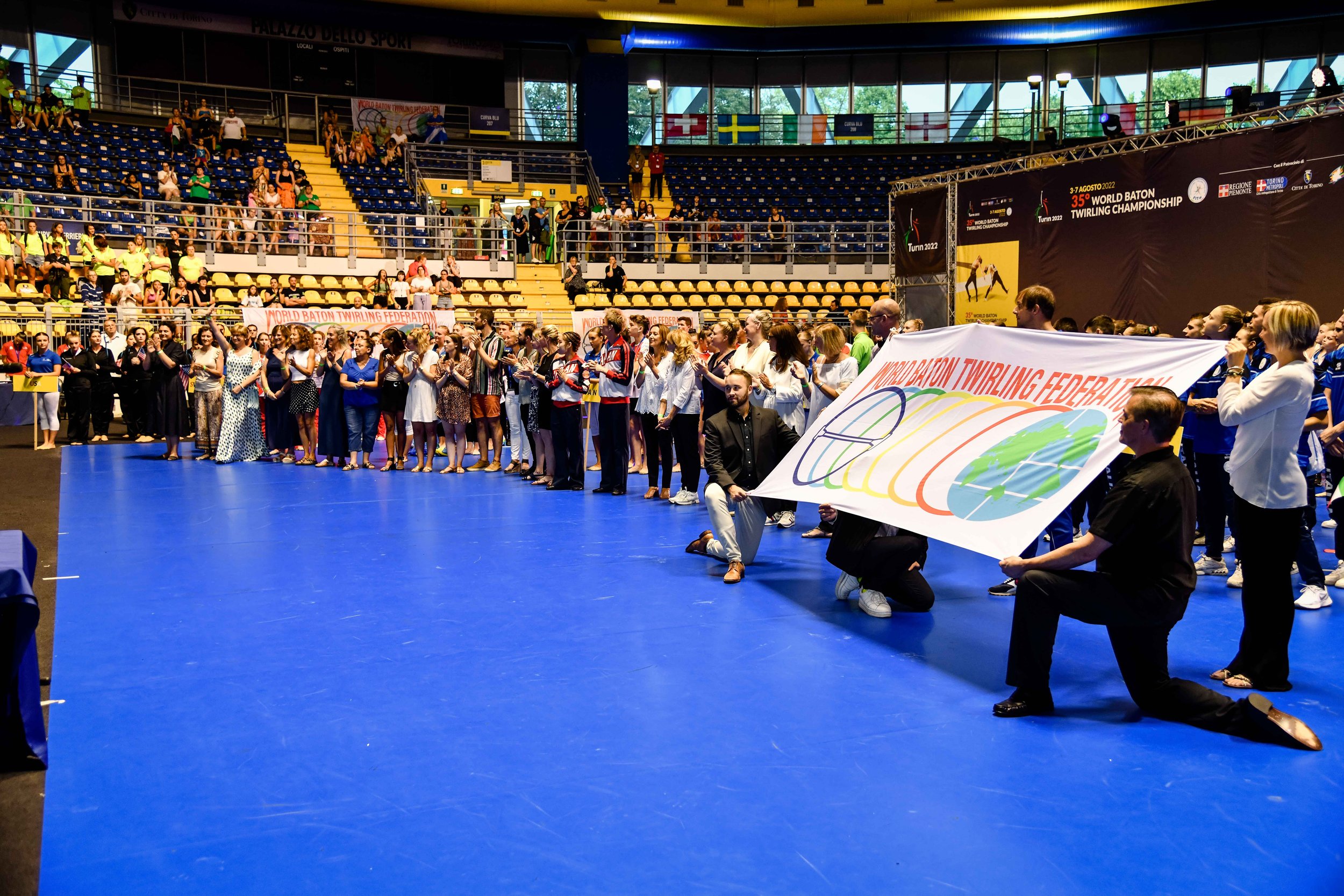
History of WBTF
Origins of WBTF
Baton twirling is a sport involving the manipulation of a metal rod with the hands and body to a co-coordinated routine. Competitive Baton Twirling encompasses the manipulation of a metal rod (baton) and the performer's body to a coordinated program of skills set to music. . It is considered a sport and contains many disciplines such as: 1 Baton Twirling, 2-Baton Twirling, 3-Baton Twirling, Artistic Twirl, Freestyle Twirling, Pair Twirling, Teams and Artistic Group.
There are many varieties of disciplines – including the majorettes who perform at a lower level of difficulty utilizing drill routines while manipulating the baton. The baton is an instrument constructed of steel with rubber ends similar in consistency to a vehicle tire. It weighs approximately ½ pound and is anywhere from 18-32 inches in length. The athlete uses a baton that is sized to the length of their arm from the shoulder to the tip of the fingers. It is weighted and balanced for air dynamic flow.
The distinguishing fundamental characteristics are:
Handling of the baton instrument to create visual images, pictures and patterns, executed with dexterity, smoothness, fluidity, and speed, both close in and around the body and by releasing the baton into the air.
Expression of the body through dance and movement to create a demonstration of strength, flexibility, physical fitness, beauty, aesthetics, and harmony in coordination with the manipulation of the baton.
The incorporation of acrobatic movements adapted to baton twirling to create additional elements of risk and excitement.
The discipline requires the simultaneous blending of these fundamental characteristics all set to music, utilizing time and space to display both technical merit and artistic expression in creating a total package for the viewer’s eye.
The origin of Baton twirling is unknown. It may have started in Eastern Europe and Asia at dance festivals where the goers used knives, guns, torches and sticks to twirl with and toss. The "activity" progressed into the armies of some countries which twirled with rifles during marches. When the army was parading, they added a rifle twirler to the front of the marchers. The rifle was then switched for a "mace". The mace was much larger than the batons of today and imbalanced. They are still used by some marching bands and parades nowadays. The mace barer or "drum major" twirled the baton while leading the army or band. This was very popular in the United States following World War II with the American Legion Bands and the Fireman’s Bands. In the early part of the century, twirlers were mostly boys and men - because the batons were very heavy.
The maces were altered for easier twirling and now resemble the batons of today. They were given smaller ends of light rubber, made from hollow light metal and balanced to give accuracy to the twirler. This lead to the involvement of females "majorettes" and the progression of twirling that resulted in the of the lightening and balancing of the baton. In the late 1930s the "majorette" made her debut,.when band directors decided to increase the audience appeal of the marching band by adding a baton twirler or two. The role became so popular that high school girls all over the country wanted to participate. Shorter, lighter batons continued to developed for the rash of feminine twirlers springing up. Through the '40s, '50s, and '60s, more and more girls became majorettes. The involvement of girls and young women made twirling a more graceful, artistic form of self-expression than it had ever been before.
In the middle of the 1950s incorporated baton twirling associations in the United States began to develop. The associations organized baton competitions on both state and national levels. Two of the largest U.S. associations today are the United States Twirling Association (USTA) and the National Baton Twirling Association (NBTA). Both hold national competitions every year and officiate at competitions at local state and regional levels.
By the 1960's, twirling the baton evolved from just being "majorettes" who marched with bands and performed at half-time of American football games into a competitive sport in the United States and later began to develop in other parts of the World in the following decades.
While many member countries have their own national organizations, the World Baton Twirling Federation governs the sport of baton twirling on an international level for its member federations.
History of WBTF
The increasing popularity of the sport of baton twirling throughout the world brought about the formation of the WORLD BATON TWIRLING FEDERATION (WBTF). An organizational meeting in London, England in 1977 brought together the leaders of the baton twirling organizations from many countries around the world. The founding President of the WBTF was Mr. John Kirkendall, from Ypsilanti, Michigan, USA.
At that meeting, the WBTF was formed to develop, encourage, and standardize the sport. With the spirit of international cooperation which characterized the London meeting, the second meeting was held in the Canary Island in 1978 at which time the By-Laws of the Federation were approved and discussion of international rules of competition were debated by the representatives.
As a prelude to the first World Competition, the WBTF conducted the first World Demonstration of Baton Twirling on March 31, 1979, in the beautiful setting of Piazza San Marco in Venice, Italy. An estimated crowd of 10,000 spectators watched as athletes performed complicated routines with precision and grace.
In October of 1979, the Federation representatives met in Paris, France to finalize all plans for the first WORLD CHAMPIONSHIPS OF BATON TWIRLING, bringing together teams of twirlers from ten countries to compete in a spirit of healthy, athletic competition. The United States Twirling Association, Inc. hosted the first World Championships in Seattle, Washington in 1980. Each successive year, one member country has hosted the championships.
Affiliate Membership was established for new and developing countries to allow close affiliation with the Federation before moving up to Provisional Membership, which then allows these new countries additional involvement prior to obtaining full membership status in the Federation. Some of the major accomplishments made over the years include the following:
1991 - the Official WBTF Constitution was signed by 14 member countries with a complete set of By-Laws and Rules and Regulations.
The main events at the first World Baton Twirling Championships were Freestyle and Compulsory Moves. Two new events were introduced: Teams (1981) and Pairs (1993). In 2005, a Short Program replaced the Compulsory Moves for the Senior Men and Women’s divisions.
New age classifications were introduced for world-class competition to ensure fairness and equality.
Provisional Membership and Affiliate Membership were added to encourage growth and participation of new countries.
2005 – The very first International Cup was hosted by the USTA in St. Paul, Minnesota. Events offered at the International Cup are: 1-baton, 2-baton, 3-baton, Team and Group. Age divisions: Junior (12-16); Senior (17-20); Adult (21 and over). Number of participants for Team (6 to 8 members); Group (10 to 20 members). Alternates: maximum 2 for Teams and Groups. The WBTF also introduced a Level A and a Level B for all events to assist new member countries. Guidelines were established for Level B events.
International Clinics taught by coaches from around the world are offered to all athletes following world competition.
A standardized Judges’ Training Program and Master Exam was established for all WBTF disciplines and events.
A standardize Coaches Training Program and certification is available for all coaches.
Many member countries have been granted official sports recognition by their National Sports Governing Body and by their National Olympic Committee.
Baton Twirling was presented to the public for the first time as a “promotional sport” at the 1993 World Games in The Hague, Netherlands.
The WBTF is committed to the ideals of democracy, fairness, and honesty; its Board of Directors work on long-range projects and oversees specific focus areas. The Technical and Judges’ Committees have standardized the sport of baton twirling through extensive testing and development.
Twirlers, coaches, judges, and parents look to the WBTF World Championships as the epitome of baton twirling excellence.
The World Baton Twirling Record Book, sponsored by Star Line Baton Company Inc. and the WBTF provides photographs, text and complete competition results for previous World Baton Twirling Championships and the International Cup, plus it also provides other articles and history of the WBTF.
We all know that the era of pleated mini-skirts and high-stepping parade marchers as baton twirlers has diminished and that baton twirling has progressed to a physically demanding, world class sport. Baton twirling has developed into a multi-faceted sport for everyone - children, adolescents, and adults. It is a great sport for recreation, school groups, community organizations, and, of course, competition.
But baton twirling is not only a sport - it is also an art. It is an art because it requires style and beauty, and a sport because it combines intense coordination to keep the baton in motion while the body moves in a graceful manner, all the while incorporating dance moves, gymnastic maneuvers, and music interpretation demanding a high level of concentration and physical exertion. In addition, baton twirling promotes sportsmanship and a competitive spirit. Baton twirling as a competitive sport encompasses the physical stamina and agility of gymnastics and dance, the artistic expression and beauty of figure skating and ballet, and the technical skill of all these sports combined.
Baton twirling has truly become a sight to behold - an entertaining and exciting sport to perform and watch. Baton twirling has become a great sport and a great activity for boys and girls, and men and women.
Participating in the sport of competitive baton twirling has given many athletes the change to learn about discipline, perseverance, frustration, uncertainty, pain, victory, even defeat. Baton twirling gives the athlete an opportunity to achieve, to feel a sense of self-esteem and personal accomplishment, and to learn about setting and attaining goals. The World Baton Twirling Championships and International Cup allow our athletes to meet new friends, learn about different cultures, and represent their country in a spirit of patriotism at the most prestigious baton twirling championships with dignity and pride.
The World Baton Twirling Federation is composed of devoted leaders, the friendly baton twirlers, and the most dedicated and supportive parents. Member countries of the WBTF believe in their organization and its ideals. The leaders of the WBTF devote their lives to an acknowledged cause - the growth and development of competitive baton twirling as a recognized sport with the promise of fair competitions for all the athletes. We hope that the sport of baton twirling will expand over all continents, so that one-day, the Sport of Baton Twirling will receive Olympic recognition.
The First World Championships
The first World Baton Twirling Championships were held in 1980 in Seattle, Washington, USA with athletes from ten countries of the World Baton Twirling Federation competing in three divisions: Junior Women, Senior Women and Men.
At this event, all three World Champions represented the United States of America:
Junior Women: Bonnie Palacious
Senior Women: Pam Harris
Men: Michael Cruz
Historical results from all of the WBTF World Championships and International Cup competitions are found in the Results section of the website.
For a pictorial history of the first World Baton Twirling Championships, please view the document attached below.
1980_Picture_Story_of_1st_World_Championships_-_Seattle_WA._USA.pdf
Pictured L to R - Three of WBTF’s Presidents: Sandi Wiemers, John Kirkendall and Lynda Garland (2008)





